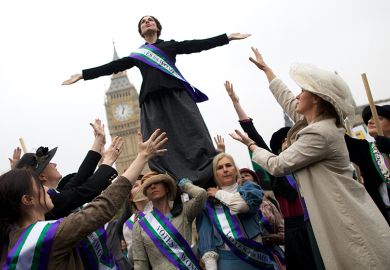These books, in three different academic genres, provide ample evidence of the flourishing state of the study of early modern women. Anne Laurence's work has the comprehensive scope and authoritative style of a textbook. It impressively synthesises a wide and up-to-date range of sources, although the section on women's writing is perhaps a little brief and sketchy. It seems odd, for instance, that the prolific Lady Mary Wroth, author of a sonnet sequence, a play and a romance, is not mentioned here, although her marriage is cited elsewhere as an example of aristocratic arranged matches. However, Laurence has lots of other fascinating material to fit in: her chapter on women's roles in material culture, for example, accompanied by some illustrations of women architects and painters and their works, makes one look forward to her forthcoming study of 17th-century women and building.
The illustrations also include a portrait of Mrs May Honeywood (15-1620), mother of 16 children, who witnessed in her lifetime the birth of 114 grandchildren, 228 great-grandchildren and nine great-great-grandchildren. She looks out at us with remarkable composure. Such vivid glimpses of individual women's lives animate the book, although Laurence is properly conscious that their atypicality may account for their being recorded and transmitted to us. She is judicious in attempting to give a picture of women's lives that is at once representative of and attentive to differences of class, race, region and period. What emerges is a sense of the narrative of women's history from 1500 to 1760 as a twine of multiple narratives.
Jenny Kermode and Garthine Walker's book is an essay collection with an impressive roster of contributors. Here, similarly, voices of individual women give immediacy, especially in the essays of Laura Gowing on defamation and Martin Ingram on scolding. Gowing reports how Alice Fullham and Ellen Alsop called each other "queen" and "bitch" in the street in 1611; Alice taunted Ellen by referring to the practices of carting whores and of banging pans and basins at women accused of scolding or whoredom: "a cart and basen tyng, a cart and a basen tyng, a cart and a basen if thou wilt not be quiet". As Gowing points out, such speech is mediated through witnesses, litigants and court clerks, but even so, the courts could enable women to present their view of events and to have it attended to and recorded.
The editors of the collection make the point that the evidence of women's contact with the law in the period complicates any model of women as confined to passive and private behaviours. Again the book makes careful use of illustrations: a picture shows a woman being punished with the "branks" or "scold's bridle", a cage-like contraption fitted over the head with a bit for the tongue and a harness, but Ingram notes that its usage seems to have been brief and regional.
Where these books seek to locate women in social history, Hutson's intricately argued monograph explores the relation of socioeconomic change to the representation of women in writing, examining how the apparent prominence of women in literature may be a metaphor for, or symptom of, other cultural anxieties. She contends that the spread of print and of humanism in the 16th century brought a crisis in male friendship, as bonds of allegiance were increasingly based on the uncertain ground of verbal persuasion and promise.
A man seeking patronage could advertise his fitness for service through his writing of "probable" rhetoric. Women could figure prominently in such writings as objects for verbal inventiveness, and in plots of wooing that displayed skill in language. Moreover, the uncertainty of verbally based allegiance could be obliquely addressed in terms of the unreliability or at least difficult detectability of women's chastity.
Hutson uses these ideas to look into areas of Renaissance culture that have previously remained shadowy or puzzling, including the works of prose fiction, in the genres of romance and novella, that were so popular in the 16th century but receive so little attention from critics and scholars today.
Many such works carried prefatory epistles and narrative asides addressed to women readers, but Hutson takes issue with critics who have read these at face value as indicating that the rise of prose fiction was connected to the rise of a female readership. She suggests that the previous dominant form of prose fiction, the chivalric romance, although ostensibly concerned with masculine deeds of knighthood, could offer scope for female agency, as in Margaret Tyler's 1578 translation from Spanish, The Mirror of Knighthood.
However, other prose works of the 1560s and 1570s, by such authors as William Painter, Geoffrey Fenton and George Pettie, which were influenced by and often sourced from Italian novellas, innovated in providing narratives of masculine success through the exercise of "probable" rhetoric in civil and domestic settings; hence their inclusion of long pro et contra debates at each turn of events. Hutson contends that the frequent concern of their plots with successful wooing, and the simultaneous presentation of these works as wooing women readers, both operate as demonstrations and models of masculine rhetorical prowess. Women may therefore appear in the foreground, but the effect is to restrict female agency.
Hutson's argument is itself highly persuasive. However, she is perhaps over-emphatic in asserting that "it is . . . when fiction ceases to be solely concerned with feats of chivalry, and begins to incorporate the endless reasoning pro et contra of which modern readers despair, that the genre begins to be associated specifically with women". This might imply that the novella superseded the chivalric mode, whereas in fact chivalric romances continued to be translated, and authored by such writers as Emanuel Forde, with considerable popularity on into the early 17th century.
It is also precisely these chivalric romances that were frequently depicted as women's reading in moral tracts, satires and readers novellas, which has lead critics to detect some association between Renaissance romance as a form of "trash" (a word used at the time) and an idea of women's reading.
But this is to quibble with an important book that offers new instruments for scrutinising the otherness of early modern culture. Hutson's intellectual rigour leads her consistently to seek answers to the most challenging questions in the field, such as why it is that Shakespeare's heroines seem to be such effective simulations of real women? In his construction of these female figures as having depth and complexity Hutson again finds that the issue at stake is "the representation of heroic masculinity as authorship". She also succeeds in avoiding the evaporation of female agency that her argument might seem to entail, in the comparisons and contrasts she draws with female writers such as Tyler and Isabella Whitney.
All three books, in their diverse ways, demonstrate that women in early modern culture are far from invisible, and that the meanings behind stories of women are plural and complex.
Helen Hackett is a lecturer in Renaissance literature, University College, London.
Women, Crime and the Courts in Early Modern England
Editor - Jenny Kermode and Garthine Walker
ISBN - 1 85728 140 3 and 141 1
Publisher - UCL Press
Price - £35.00 and £11.95
Pages - 216pp
Register to continue
Why register?
- Registration is free and only takes a moment
- Once registered, you can read 3 articles a month
- Sign up for our newsletter
Subscribe
Or subscribe for unlimited access to:
- Unlimited access to news, views, insights & reviews
- Digital editions
- Digital access to THE’s university and college rankings analysis
Already registered or a current subscriber?



